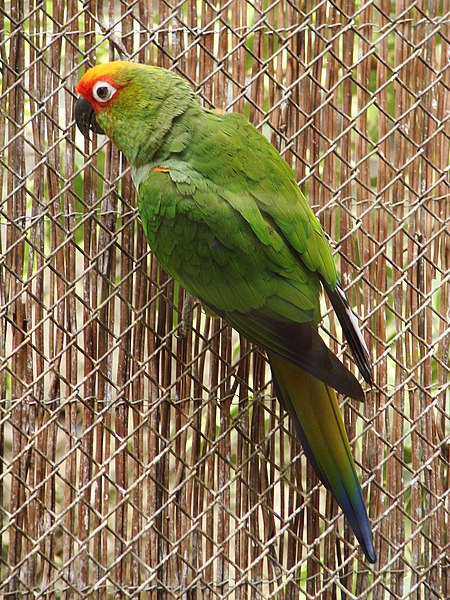The Golden-Capped Conure (Aratinga auricapillus), also known as the “Golden-capped Parakeet” or “Golden-crowned Conure”, is a medium-sized species of conure parrot that belongs to the genus Aratinga in the family Psittacidae. It is native to the tropical forests of South America, specifically the regions of Brazil, Colombia, Ecuador, French Guiana, Guyana, Peru, Suriname, and Venezuela.
In terms of physical characteristics, the Golden-Capped Conure typically measures around 30cm in length and weighs between 120-135 grams. They have a relatively short tail, and their wings are relatively short and broad. They have a distinctive golden-yellow patch on their forehead and crown, which can be used to distinguish them from other Aratinga species. Their beak is strong and curved, adapted for cracking seeds and nuts. The body plumage is primarily green, with blue-green on the head, red-orange on the shoulders, and a blue-green tail. The underwing coverts are yellow, and the flight feathers are blue-green.

In terms of behavior and ecology, Golden-Capped Conures are social and gregarious birds, often found in flocks of up to 50 individuals. They are active and playful, known to engage in aerial acrobatics and foraging behaviors. They have a wide vocal range and are known for their loud calls and screeches. They feed on a variety of seeds, fruits, and nuts, and have been observed using tools to obtain food.
In terms of conservation status, The Golden-Capped Conure has considered a near-threatened species due to habitat loss, illegal trapping for the pet trade, and the wild population is declining. It’s important to ensure that the trade of wild-caught individuals is regulated and efforts are made to protect and preserve their natural habitats. In captivity, they are known to be hardy and adaptable but require a significant amount of attention and mental stimulation to thrive, they have a lifespan of around 20-30 years with proper care.
Gold-Capped Conures and Screaming
The scenario usually goes something like this. You bring your beautiful and stunning gold-capped conure home and all is well. He’s cuddly, cheerful, playful, and possibly the best bird on the planet. He greets you with a cheerful scream when you enter the room and he actively engages you to play.
Then something changes. He becomes nippy, the screaming occurs more frequently – driving you, your family, and your neighbors insane, and he’s no longer interested in playing with you without biting.
- Make sure your Gold Capped Conure is eating well and getting plenty of sleep.
I know this sounds extremely basic but think of it this way. How happy are you when you get half of the sleep that you need and you’re only food for the day is a bag of chips and a cup of coffee? I don’t know about you but I’m about as crabby as a cat being chased by a teething puppy.
What does a good diet mean for a gold-capped conure? It means an organic, non-colored, pellet diet with plenty of fresh fruits and veggies. It does not mean a diet full of seeds and nuts. This kind of diet will kill your bird and I’m not exaggerating here. Seeds and nuts, while yummy to your bird, are extremely fatty. This will fill your conure’s liver with fat, it will slow down his metabolism, and literally destroy his immune system. There have even been studies that show that a seed and nut-based diet causes cancer.
Now let’s talk about sleep. Your Gold Capped Conure needs 12 hours of sleep in a dark and quiet room. If this means that you have to move him out of the main living space and into a dark room every evening after dinner, then take those steps. It’s the first step toward having a happy, healthy bird, one that doesn’t constantly scream and bite.
- Some birds may be content to sit in a cage all day but not Gold Capped Conures.
They are intelligent birds that need to be active and interact. They thrive on stimulation and interaction. This means that their cage must be big enough for them to roam and explore both horizontally and vertically. It also means that you must take on the responsibility as their owner to provide a multitude of toys and chewable for your conure to explore and yes to destroy. This means you’ll be replacing toys frequently but if your bird’s bored he’s going to take it out on you. Spend a few bucks and buy him some great toys.
- Training
Trick training accomplishes these three things: it teaches your bird through positive reinforcement to trust you, it teaches your bird that you’re the boss and biting and screaming are not acceptable, and it teaches your bird that trick training is a fun and stimulating game that he can play with you. Best of all, it will bring your bird back into the loving folds of your family instead of having to keep him behind bars and under lock and key.
